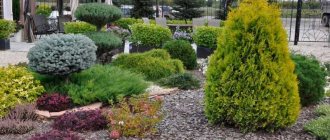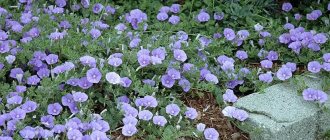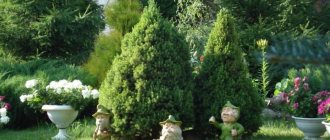Benefits of using hostas for garden decoration
Hostas (funkias) are quite popular plants that can often be found in the garden. The secret to their widespread use is this:
- Unpretentiousness in cultivation - these flowers do not require any special conditions or soil components.
- The plant is a real long-liver - it grows and blooms successfully in the country for 20 years, and sometimes more.
- It is not for nothing that Hosta is considered the queen of shade - it prefers semi-shaded or even heavily shaded places, so it can be used in almost any part of the garden.
- Greenery can have different shapes (round, heart-shaped, narrowed) and surface characteristics (smooth, wrinkled, matte, grooved, etc.), so it goes well with a wide variety of colors.
- In addition to garden design, hostas (especially their green part) are used in creating beautiful flower bouquets.
- Plant varieties are extremely diverse in stem height (some grow up to 19-20 cm, others can rise up to a meter). Thanks to this, you can create a wide variety of flower arrangements.
Important! Since hostas live and decorate the site for a very long time, gardeners initially carefully determine the place where the plant will feel most comfortable. To do this, you can plant 2-3 identical flowers in places with noticeably different conditions (shade, soil, level above the ground) and see after a year where the flowers are most bright and where the greenery grows the most.
Choosing a location and optimal growing conditions
Choosing a place for a flower is very important, because it is supposed to be planted not for 1 season, but for a long time. It is better to take care of growing conditions in advance, taking into account the following rules:
- Different varieties of the “queen of shadows” have a common property: they love shaded conditions with inconsistent sunlight. Therefore, their flower beds are often located near garden trees or outbuildings. The fact is that if you plant flowers in an open area, then strong sun can have a bad effect on the coloring of the greenery - over time it will become paler, and burns may also appear.
- Hostas love moisture, so it would be optimal to plant them in low-lying areas of the garden, where moisture will accumulate after heavy rains, or near artificial reservoirs. If the summer is dry, then you will need to water frequently and abundantly - flowers do not develop well on dry soils.
- Plants should only be planted in well-dug soil. Large earthen stones must be broken. If weed rhizomes are found, they should be removed.
Important! The decision to choose a location must be made taking into account the characteristics of a particular hosta variety. For example, varieties with rich green leaves like strong shade, while plants with yellow-orange shades of green prefer semi-shade. For them, the best option would be a place that is well lit in the morning and almost completely goes into shade during the day.
Landing rules
Hosta is a herbaceous perennial with a dense fibrous root system. Loves shady places and moisture, this must be taken into account when planting. Propagated by cuttings and seedlings grown from seeds. The instructions for planting hostas contain two important factors on which success depends: the choice of location and soil.
- Place for a seedling
The successful development of the seedling and its longevity depend on a competent approach to planting activities. Hosta does not like transplants, and in the right place it will grow for more than 20 years.
Hosta is called the queen of the shady garden. Choose partial shade and a place protected from drafts for it. The northern side of buildings, fences, and the proximity of tall trees are suitable.
Depending on the hosta variety and foliage color, conditions may be adjusted. For example:
- Variegated species require the presence of the sun to maintain color saturation. In constant shade the foliage will be dull. Plant in areas that will receive morning/evening sun.
- Leaves with a light center - can be planted in more illuminated areas, with light partial shade. This rule applies to white and yellow varieties.
- Blue hostas grow well in the shade and receive enough UV for up to 2 hours a day. The scorching sun is contraindicated for them - the charm of blue will disappear.
Shade affects the growth and aesthetics of the plant. The thicker the shadow, the taller the bush, the larger the leaves, the slower the growth. Photo: sadkom.ru
- Soil for seedlings
For hosta, the soil is not particularly important; it is not picky and grows everywhere. The exceptions are sand, rocky soil and dense clay. The reaction to slightly acidic, neutral and fertile soil will be:
- accelerated growth,
- rich color,
- powerful petiole,
- large leaf.
Hosta grows and develops best in neutral, slightly acidic and fertile soil. Photo: dachniki.xyz
- Boarding time
Hosta can be planted in spring and autumn: late April/early May, September. A seedling grown in a container can be planted at any time of the year.
The root of an adult bush is cut into pieces and used for propagation. Photo: countryhouse.pro
- Landing
- The straightened roots are buried 2–3 cm into the prepared hole.
- The tree trunk circle is mulched with peat or sawdust.
- In group plantings, hostas are planted at a distance of 40–100 cm from each other, the interval depends on the variety.
A layer of mulch is 2–3 cm. Photo: ogorod.ru
It is practiced to grow hostas in containers. Due to the small amount of soil, the roots freeze. Requires shelter or a milder climate.
Photo gallery
Hostas in solitaire plantings
One of the features of the hosta, which distinguishes it from many other ornamental plants, is that it is completely self-sufficient in order to be used in individual plantings. Such plantings are also called solitary plantings. For this method of decoration, varieties with large bushes and bright greenery that contrast against the general background of the garden are suitable.
Solitaire hosta plantings can be used for the following purposes:
- planting in corners of the garden to define natural boundaries;
- seating on elevated surfaces allows you to visually make the hosta even larger, which emphasizes its flowers especially well;
- finally, an excellent option for solitary planting is semi-empty places where there are no other plants nearby; thus not only filling the void, but also highlighting the funkia flowers.
Important! When carrying out such planting, you need to prepare the soil well - it is advisable to make the area level and plant small greenery on it to create a beautiful background against which the dark foliage of the plant will contrast well.
Living border of hosta
Hosta is the queen of the border. And this is well deserved. Stable decorativeness, original foliage color, long flowering, frost resistance, unpretentiousness and undemandingness - all this is hosta. Of course, it will take several years until the plant grows to its final size and acquires the color characteristic of the variety, but then you will enjoy a beautiful border for many, many years.
Brian Turner / Flickr.com
Probably, no plant in the world provides such a huge selection of all possible varieties in the shape and color of the leaf blade, the pattern and venation of the leaf, the presence and degree of wax coating, the waviness of the edge, the color of the flowers. Hosta, like no other garden perennial, can effectively and advantageously highlight the main plants of a flower garden or flower bed.
The most suitable hosta varieties for borders will meet two requirements - the height of the plant should not exceed 40-50 cm, and the variety should not be afraid of sunlight, since borders are usually located in open and sunny areas for most or most of the day (paths, lawns, areas in front of the house). It is desirable that the shape of the bush of the variety is compact, dense, with beautifully and harmoniously arranged leaves. Let's list the best and popular varieties : “ Diamond Tiara ” (30 cm, shade-partial shade), “ El Nino ” (45 cm, shade-light shade), “ Gold Standard ” (40 cm, all except bright sun), “ Halcyon " , dim sun), " June "/" June Fever "/" Remember me " (40-45 cm, any-light shade), " Stiletto " (25 cm, partial sun), " Wide Brim " (50 cm, light shadow), " Wolverine " (45 cm, light shadow), " Hanky Panky " (40 cm, light shadow) " So Sweet " (50 cm, sun-shade).
peganum/Flickr.com
If you need to arrange a very low border, then such, one might say, miniature hostas as “ Blue Mouse Ears ” (15-20 cm, shade-sun), “ Pacific Blue Edger ” “ Island” may be suitable Charm " (15-20 cm, light shadow).
large hostas will look surprisingly good in such borders . This type of border design can be afforded if it is located near large trees and is partially or partly in the shade, but there are varieties of large hostas that will beautifully border large plantings even in direct sun. You can’t find anything better than hosts for these purposes. Large hostas look very beautiful and even monumental. " Aureomarginata " (70 cm, any lighting conditions), " Guacamole " (70 cm, sun-shade), " Liberty " (70 cm, light shade), " Sum and Substance " ( up to 120 cm, open sunny places) , “ Sagae ” (up to 90 cm, light shade), “ Regal Splendor ” (up to 90 cm, light shade-partial sun), “ Sun Power ” (70 cm, shade-sun). The varieties listed here are just a drop in the sea of hostas, but let this drop turn into a sea of love for these amazing and spectacular plants. And they, in turn, will delight you for a long time.
Dornenwolf / Flickr.com
You can arrange a mono-border from one hosta variety - this option will be good for strict geometric shapes of flower beds and ridges. You can arrange a border of two contrasting and alternating varieties - it looks very nice and does not clog up the space. You can create a border from various similar groups of hostas (only medium, or only small) of different varieties, selecting the color of their leaves and patterns and alternating them in groups - this option is more suitable for free, without geometric lines, flower beds. With a plant like hosta, there are so many options for creativity. Just experiment and try.
good and harmonious neighbors for hostas when creating a border, from which you can easily choose a plant with a contrasting color or, conversely, one with a close and matching color. In bright planting areas, it will be interesting to be next to and/or alternate with low daylilies. For large hostas in shady plantings, ferns will be the best partner.
Dan Keck / Flickr.com
Before purchasing hostas, especially in large quantities for the border, draw up a planting plan . On it you need to mark the cardinal directions and the number of plants, based on their height and diameter of the occupied area. This is necessary in order to correctly calculate the amount of planting material so that the hostas do not climb on top of each other in a few years, and so that there are no voids on the border. And also you must select varieties depending on the side of the world where a certain variety will grow. The degree of illumination plays a huge role in the color of hosta foliage . That is why do not buy hostas spontaneously, and then nothing will stop you from enjoying their beauty. Remember another important point: the color of the leaves of a young plant can differ significantly from the color of an adult hosta.
Options for using hosts in landscape design
The variety of varieties allows them to be successfully integrated into gardens with a wide variety of designs. You can use flowers to create classic flower beds, plant them in combination with other plants, or create entire multi-tiered compositions that well organize the interior space of the site. Everything mainly depends on the gardener's ideas. In this case, the height of the plant is of great importance - large ones are often planted singly, and small ones serve as the basis of a flower arrangement. Here are just some design moves that can be used when planting hostas:
- Planting small bushy hostas (no more than 20-25 cm in height) in a continuous strip is well suited for emphasizing slopes, in the corners of the garden, as well as for rockeries (small rocky flower beds of various shapes). Such low species are also called ground covers - they perfectly hide the soil and create the effect of a green root. Also, in the shade of their thick leaves, some weeds die from lack of light
- Varieties with a height of 28-30 cm are well suited for creating green borders. They can be planted both around the perimeter of the garden and on the internal borders that separate one group of flowering plants from others.
- Hostas with an average stem height (up to half a meter) are often used to create compositions with other varieties or other crops. They highlight tall and medium-sized plants well (especially lilies and gladioli).
- Taller plants (from half a meter to 60-70 cm) are often used for planting along ponds and garden paths. They create a framing effect that visually highlights the paths. They also form a background for taller flowers.
- The tallest hostas are used in solitaire plantings, as discussed above. They also fit harmoniously into rock gardens - among the large stones, the image of a large branched tree growing in the mountains is created. In addition, against the background of light stones, the plant contrasts well due to its dark greenery.
- A hosta flowerbed can be created from plants that are uniform in height, or from plants that are different. The latter option is often more interesting, since you can create a multi-tiered composition with a gradual increase in height from the edges to the center. This allows you to feel the effect of movement and organize the space of the flowerbed on which you can plant other flowers.
Where and with what to plant in the garden
Lush, beautiful hosta bushes are often combined with other plants in a home flower garden. The result is very successful compositions, crops that do not interfere with each other’s growth.
Green background for bright flowering plants Source wohndesign.abetternc.org
Hostas and perennial flowers
Excellent contact with various perennials. For example, they practice planting hostas with bergenia, hellebore and daylily. If a flower bed is created near a reservoir, it is recommended to additionally plant irises, lungwort, and anemone. In such cases, it is important to distribute the vegetation according to height. For example, decorative flowers with short stems should be planted closer to paths and borders. This includes the miniature hosta. Bushes that reach a height of up to half a meter, of course, are best planted at a separate distance. They will be visible from there too.
Hosta and roses
It is known that the rose is a light-loving plant, so it is especially picky about its neighbors. Hosta will become a real “friend”, as it can prevent excessive weathering of moisture from the soil and prevent the appearance of insect pests on roses. It is important to plant any varieties of crops together with prickly flowers. At the same time, you should not be zealous, because too many hostas will begin to draw a lot of moisture under themselves. The recommended gap between roses and shade-loving crops is 35-45 cm. An excellent option is edging a flower bed with hosta roses.
Hosta and astilbe
Compatibility is observed between hostas and astilbe in the same flower garden. An excellent decoration will be the leaves of the decorative crop, which can be yellow, light green, blue, or gray. Astilbe dimensions reach up to 70 cm in height. Plants planted together are able to maintain their decorative properties until frost occurs. Both crops are shade-loving and prefer moisture. Therefore, they are often planted under trees.
Note to the owner! Astilbes and hostas feel great in a gravel bed at the same time. In such conditions, they try to plant them according to their height.
Hosta and daylilies Source keosan.com.ru/
Hosta and daylily
Different varieties of hostas and daylilies harmonize well with each other. The first plants are distinguished by different shapes and colors of leaves, and the second by the shade of flowers. The result is a rather beautiful tandem. There are no special requirements for growing such a combination.
What hosta goes with: choosing plant companions
Along with many of the advantages discussed, the hosta has one more: it does not compete with other plants and gets along well with most of them. The only exceptions are those who love an abundance of light. For example, roses require a lot of sun, and hostas, as already mentioned, prefer partial shade or even strong shade, so they are not grown together.
Among other colors, funkia goes well with the following:
- ferns;
- conifers;
- geraniums;
- lungwort;
- primrose;
- digitalis;
- Horny goat weed;
- astilbe;
- gladioli.
It can not only highlight their bright flowers, but also show their beautiful sides due to the contrast of greenery (for example, against the backdrop of bright green ferns).
Compositions from hostas and other plants
When creating compositions, it is important to take into account not only the design of the future flower bed, but also the matching growing conditions (abundance of moisture and shelter from direct sunlight)
Flowerbeds with heucheras and hostas
The composition of hosta with heuchera is one of the most successful options of its kind. This is explained by the fact that heuchera has flowers of delicate light shades (from white to red). They stand out well thanks to the juicy, dense greenery of the funkia. When creating a composition of these crops, it is important to take into account that heuchera grows up to half a meter in height, so it can be planted in various combinations with low-growing hosta. If the choice fell on large and tall hostas (from 80 cm to a meter), then they should always be planted in the background so that the heuchera does not get lost in their bushes.
Hostas in combination with astilbes
Astilbe and hosta share a love for shade, which is why they are often used together when creating compositions. The options for their use are limited only by the gardener’s imagination. Here are just a few of them:
- Create a beautiful garden frame using alternating hostas and astilbes.
- Arranging a flower arrangement to create a border along garden paths or ponds.
- An excellent option is a circular composition around a shady garden tree, which will fill the empty space underneath it.
- Finally, such compositions are often used to frame a lawn with even greenery in bright shades.
Other flower arrangements
Hosta fits into flower beds and other types of compositions with many plants, since varieties have different stem heights.
Basically, design moves are based on 2 ideas:
- Contrasting bright colors against the background of dark green hostas - gladioli, lilies, irises, delphiniums. The plant also contrasts well against the background of soft green foliage (small lawn vegetation, ferns).
- Creating multi-tiered compositions with height differences due to hostas and other plants. For example, the same gladioli can be placed in the background, and small varieties of hosta can be grown right in front of them. This will create the effect of upward movement due to the tiering and shape of the gladioli flowers.
Functionia can be used in a variety of ways, since there are many types of plants, and each of them has its own characteristics. At the same time, caring for the plant will not be difficult, so hosta is the choice of many gardeners, both among amateurs and professionals.
What to plant next to hostas
Hosta diseases
What does hosta go with in a flowerbed? These ornamental plants get along well with all flowers, so the question of what to plant next to the hosta does not arise. Previously, this perennial plant could rarely be found in flower beds and flower beds. It was considered something special among the usual plants and flowers. Modern varieties decorate flower beds and paths. They look wonderful surrounded by roses, peonies, hydrangeas, and irises. A good tandem of hostas in a flower bed with geraniums. These plants are a decoration for any flower garden: from a ceremonial composition to a shady corner in a landscape style.
Hosts in company with peonies
Use these attractive plants in your flower beds to enhance the attractiveness of the flowers around them. Large, ornamented hosta leaves soften, soothe, balance plants of various natures, and enhance the beauty of their neighbors, namely:
- Flower beds with daylilies and hosta. Low-growing types of daylilies are grown in the garden plot. They mainly decorate flower beds that look like alpine slides. At the forefront of the composition, florists recommend planting hostas with beautiful foliage. Depending on the design for the alpine hill, they select a scheme for planting bushes, alternating them with daylilies, which are suitable for any soil and diffused lighting.
- Flowerbed with phlox, heuchera and hosta. A skillful combination of heuchera and hosta with an eye-catching variation in the shades of one and the other flower transforms the area, be it a flower bed, lawn or alpine hill, and attracts attention. Both flowers are easy to care for and resistant to disease, frost and dry weather. Corners of garden plots decorated with heuchera and hosta are a real highlight of the design. In a semi-shaded area of the garden, perennial phlox will look like a bright spot, blooming almost all summer until mid-autumn. Dry summers, like winter frosts, are not so sensitive for phlox.
Combination of heuchera and hosta











